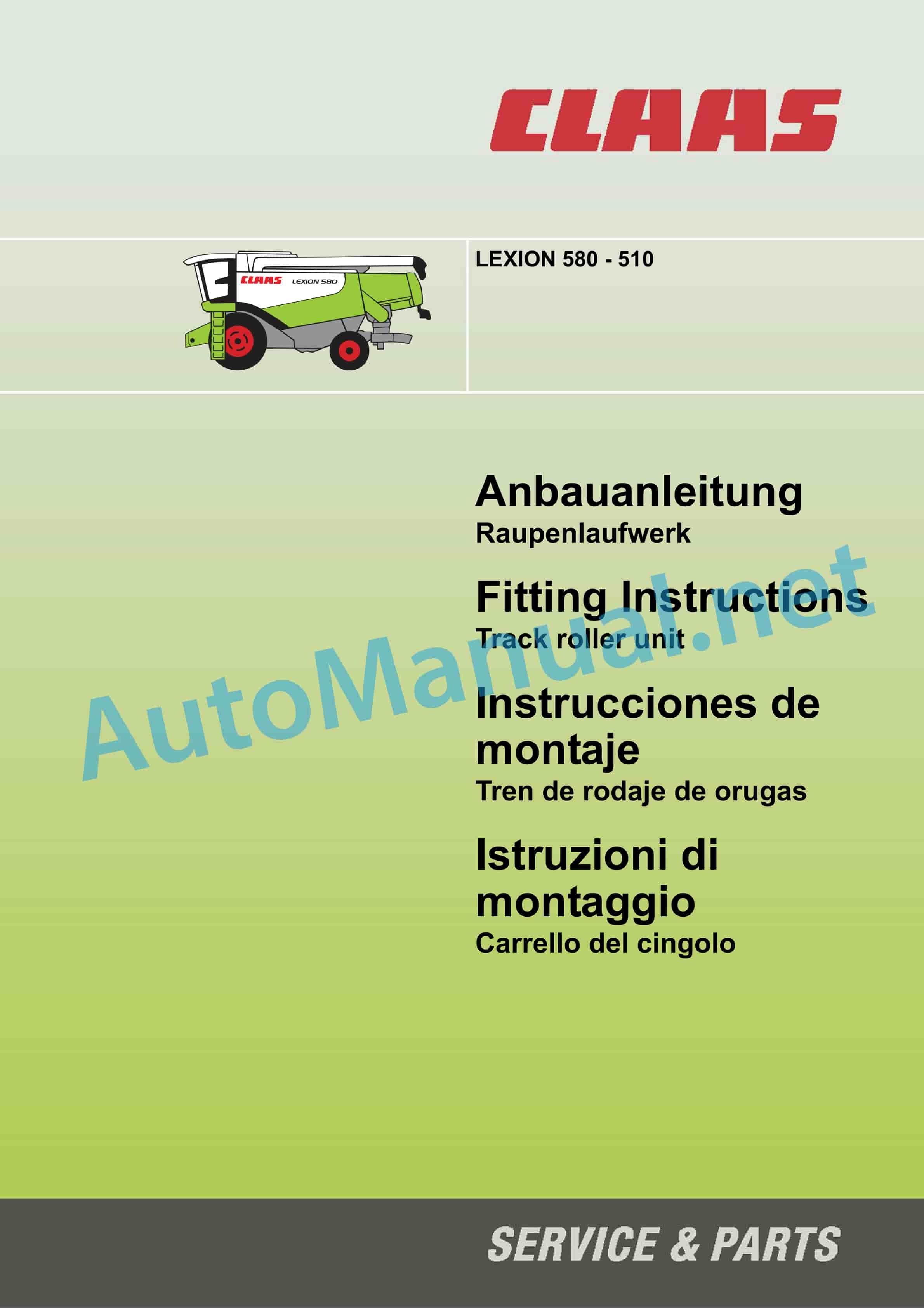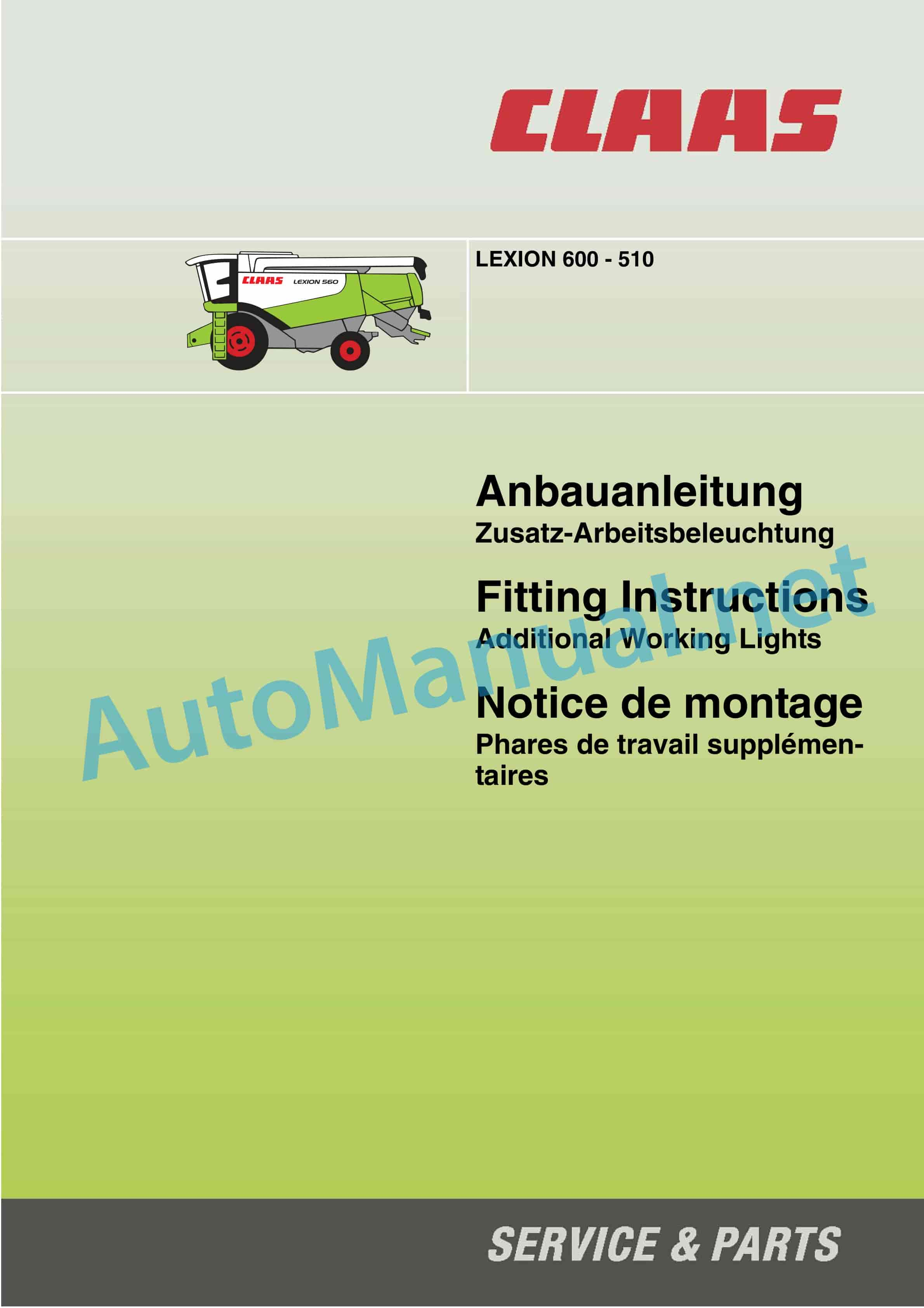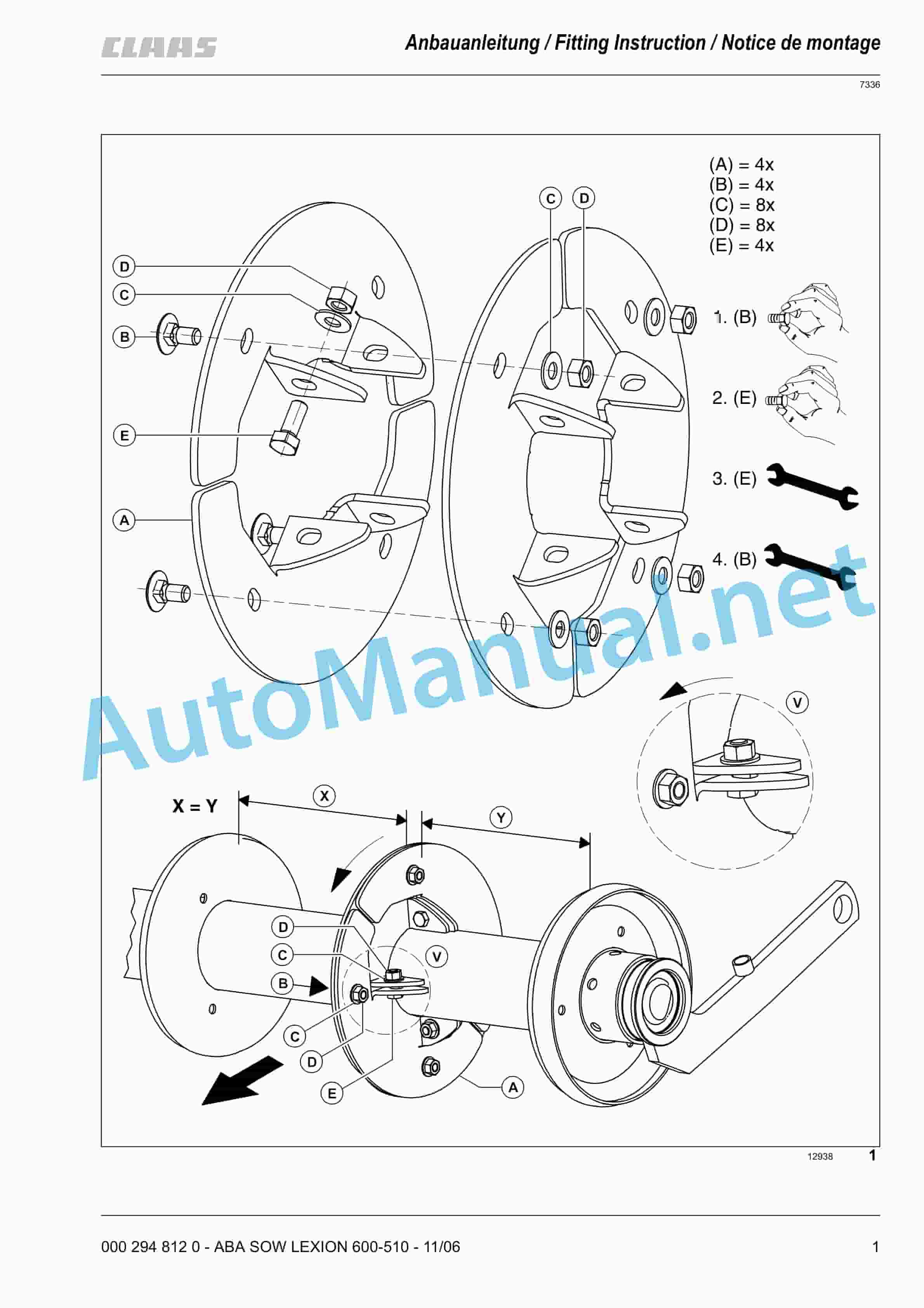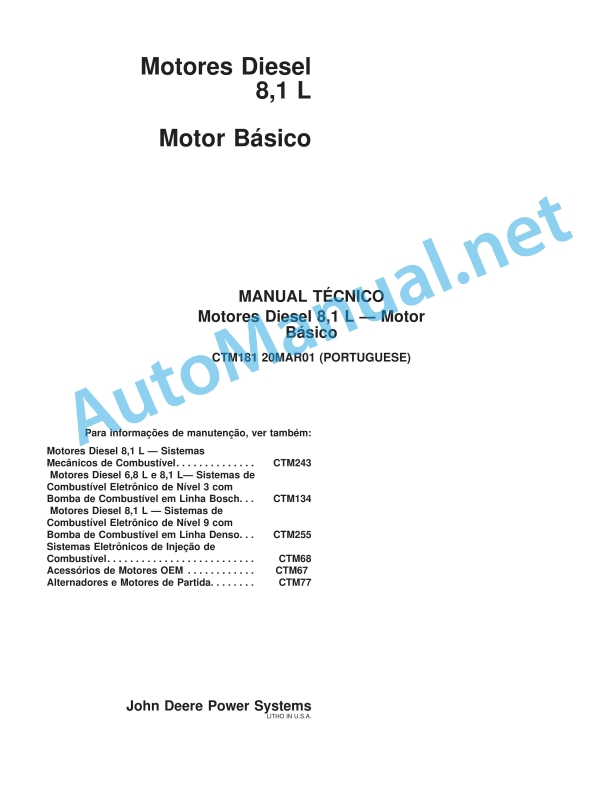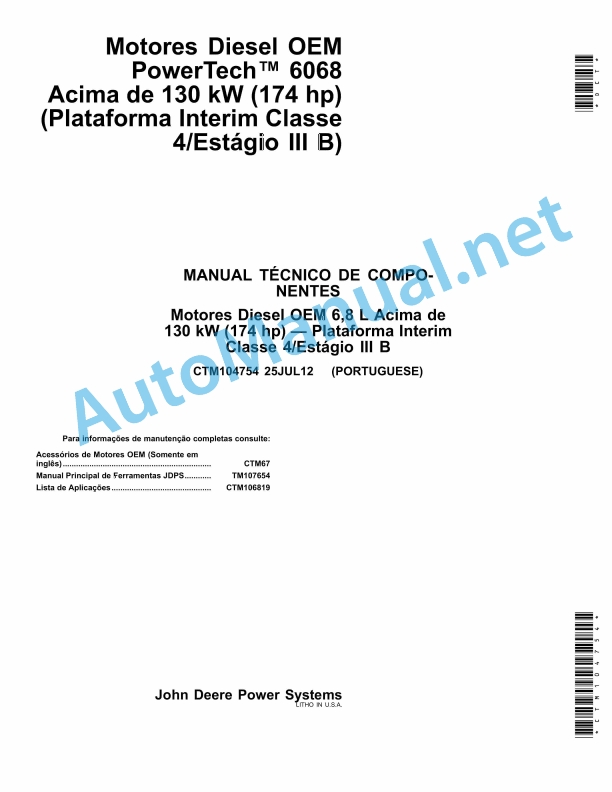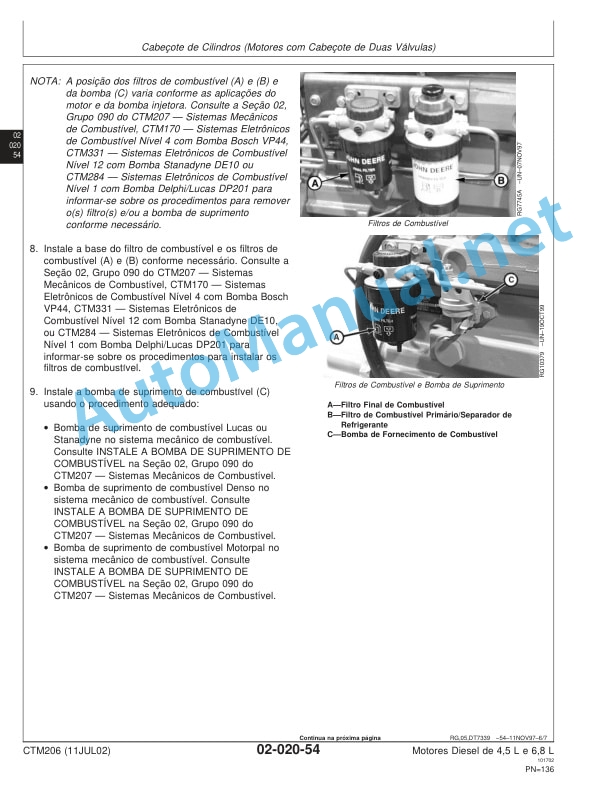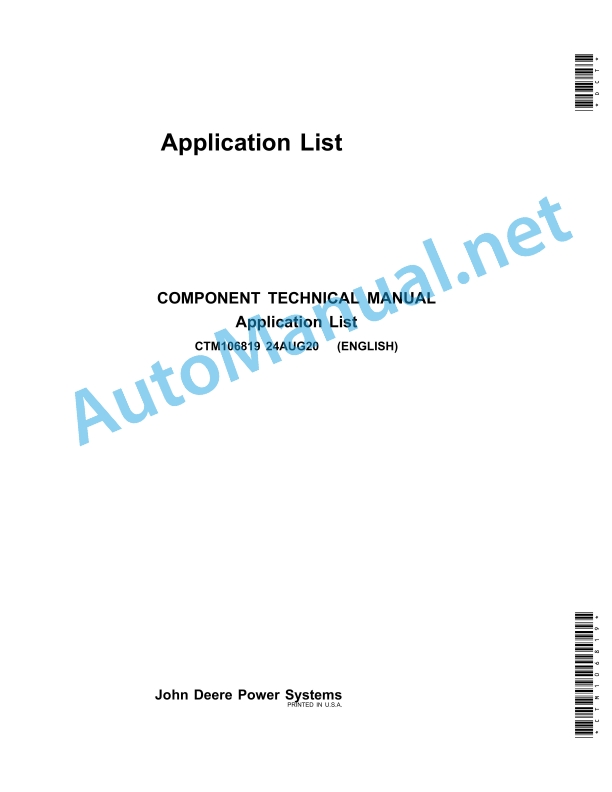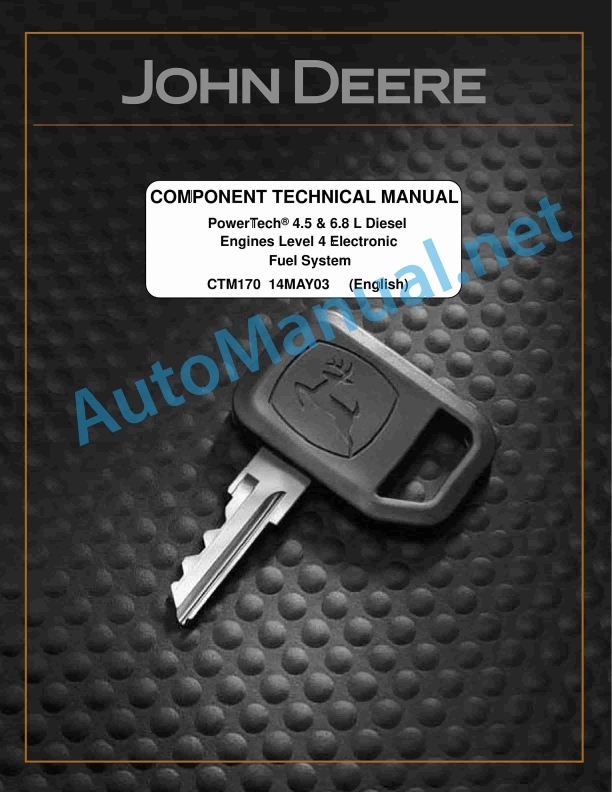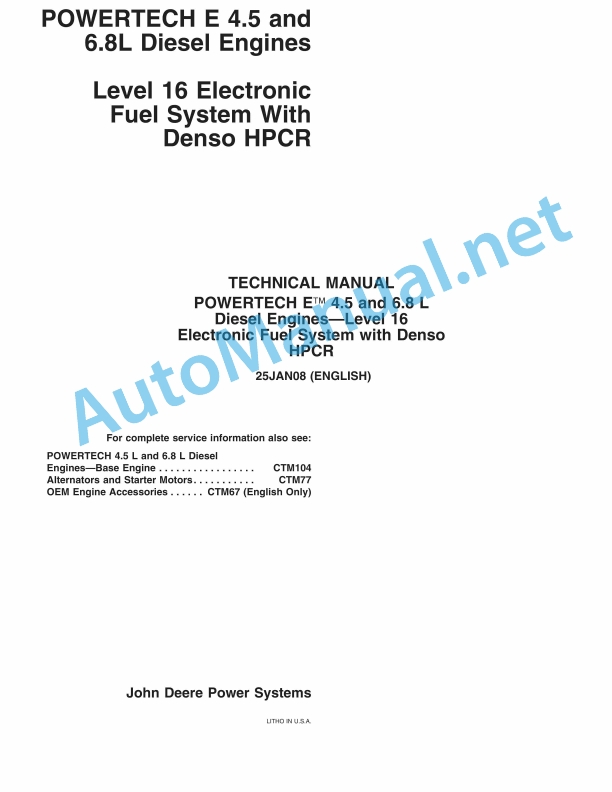Claas LEXION 570 580 R (585) Combine Assembly Instruction DE
$30.00
- Model: LEXION 570 580 R (585) Combine
- Type Of Manual: Assembly Instruction
- Language: DE
- Format: PDF(s)
- Size: 36.3 MB
File List:
– 00 0293 232 3.pdf
– 00 0293 283 1.pdf
– 00 0293 778 0.pdf
– 00 0293 947 1.pdf
– 00 0293 949 0.pdf
– 00 0293 951 0.pdf
– 00 0294 649 1.pdf
– 00 0294 812 0.pdf
00 0293 232 3.pdf
Table of Content:
5 1 Introduction
5.1 1.1 General information
6 2 Security
6.1 2.1 Note
7 3 Scope of delivery
7.1 3.1 Tracked track
8 4 cultivation
8.1 4.1 Installing the crawler track
8.2 4.2 Dismantling the crawler track
8.3 4.3 Converting the crawler track
9 1 Introduction
9.1 1.1 General Information
10 2 Safety precautions
10.1 2.1 Important
11 3 Package list
11.1 3.1 Track roller unit
12 4 Mounting
12.1 4.1 Fitting the track roller unit
12.2 4.2 Removing the track roller unit
12.3 4.3 Fitting the track roller unit
13 1 Introduction
13.1 1.1 General indications
14 2 Medidas de seguridad
14.1 2.1 Observar
15 3 Conjunto de suministro
15.1 3.1 Tren de rodaje de orugas
16 4 Montaje
16.1 4.1 Montar el tren de rodaje de orugas
16.2 4.2 Dismounting the tren de rodaje de orugas
16.3 4.3 Transformer of the tren de rodaje de orugas
17 1 Introduction
17.1 1.1 General indications
18 2 Sicurezza
18.1 2.1 Because osservare
19 3 Complessivo di fornitura
19.1 3.1 Carrello del cingolo
20 4 Montaggio
20.1 4.1 Monday of the carrello of the cingolo
20.2 4.2 Monday of the carrello of the cingoli
20.3 4.3 Conversion to cingoli
00 0293 283 1.pdf
Table of Content:
4 1 Introduction
4.1 1.1 General information
5 2 Safety instructions
5.1 2.1 Note
6 3 Scope of delivery
6.1 3.1 Retrofit kit 91008021 / 91010189
7 4 cultivation
8 4.1 Attachment quick stop
10 4.1.1 Putting the machine out of operation
13 (Fig. 1)
15 4.1.2 Install attachment quick stop
19 – Use special tool (V) to create negative pressure in the hydraulic oil tank (P) or drain hydraulic oil.
20 – Special tool: valve combination for generating negative pressure, spare part no. 000 181 619 1.
21 (Fig. 2)
25 – Screw on the hose line (L) from the coupling (K).
26 – Unscrew coupling (K).
27 (Fig. 3)
31 – Screw on the coupling (1) using the existing cylinder screws.
32 (Fig. 4)
36 – Screw on the brake disc (2) with screws (3). Make sure that the smooth flange surface is on the inside.
37 (Fig. 5)
41 – Screw on the support (4) and flat iron (5) with screws (6) and (7).
42 (Fig. 6
46 – Screw the screw-in socket (8) into the brake caliper (9).
47 (Fig. 7)
51 – Screw the brake caliper (9) to the support arm (T) and support (4) with screws (10).
52 – Tightening torque = 123 Nm
53 (Fig. 8)
57 – Remove plug (S).
58 – Unscrew holder (H).
59 (Fig. 9)
63 – Remove the blind plugs (B).
64 – Lightly grease connecting pieces (11).
65 – Insert connecting pieces (11) into the valve disk (12).
66 (Fig. 10)
70 – Screw on the valve disk (12) with screws (13).
71 – Tightening torque = 25 Nm
72 (Fig. 11)
76 – Screw on holder (H) with existing screws.
77 – Screw on the hose line (14).
78 Tightening torque = 35 Nm
79 – Screw on the hose line (15).
80 tightening torque = 35 Nm
81 (Fig. 12)
85 – Screw the hose line (14) to the brake caliper.
86 – Screw on the hose line (L).
87 (Fig. 13)
91 – Remove blind plug on the hydraulic pump.
92 – Screw in the screw-in socket (16).
93 – Screw on the hose line (15).
94 (Fig. 14)
98 – Insert relay (17) into position (K15).
99 (Fig. 15)
106 Bleeding brake caliper hydraulic cylinder
107 – Connect the ventilation hose (L) with the collecting vessel to the ventilation valve (M).
108 – Switch on diesel engine.
109 – Loosen vent valve (M).
110 – Mechanically actuate the electromagnetic valve quick stop attachment (Y101) and circulation valve (Y77) using an auxiliary tool.
111 Auxiliary tool: pin 2 mm
112 Hydraulic oil must come out without bubbles.
113 – After closing the vent valve (M), stop operating the solenoid valves.
114 – Switch off diesel engine.
115 (Fig. 16, 17)
117 4.1.3 Prepare and carry out a test run
118 – If necessary, carry out the following work before the test run:
119 – Tighten screw connections of all newly installed parts.
120 – Install previously removed safety devices.
121 – Check hydraulic oil level. Refill if necessary.
122 – Check transmission oil levels of installed components. Refill if necessary.
123 – Put the used tool back.
124 – Check retrofitted and/or removed electrical connections.
125 – Lubricate all newly added lubrication points.
126 – Check settings on the machine.
127 – Carry out a test run.
128 – Check hydraulic oil level. Refill if necessaryions
128.3 3 Package list
129 4 Mounting
130 4.1 Front attachment quick stop
132 4.1.1 Putting the machine out of action
135 (Fig. 1)
137 4.1.2 Fitting the front attachment quick stop
141 – Using the special tool (V), create a vacuum in the hydraulic oil tank (P) or drain hydraulic oil.
142 – Special tool:Valve combination for generating a vacuum, spare part no. 000 181 619 1.
143 (Fig. 2)
147 – Unscrew hose line (L) from clutch (K).
148 – Unscrew the clutch (K).
149 (Fig. 3)
153 – Bolt on clutch (1), using the existing cheese-head screws.
154 (Fig. 4)
158 – Bolt on brake disc (2) using bolts (3). Ensure that the smooth flange face is on the inside.
159 (Fig. 5)
163 – Bolt on support (4) and flat bar (5) using bolts (6) and (7).
164 (Fig. 6)
168 – Screw the male connector (8) into brake caliper (9).
169 (Fig. 7)
173 – Bolt the brake caliper (9) down to the supporting arm (T) and support (4), using bolts (10).
174 – Tightening torque = 123 Nm
175 (Fig. 8)
179 – Disconnect plug (S).
180 – Remove bracket (H).
181 (Fig. 9)
185 – Remove the blind plugs (B).
186 – Slightly grease the connecting pieces (11).
187 – Insert the connecting pieces (11) into the hydraulic valve (12).
188 (Fig. 10)
192 – Bolt on hydraulic valve (12) using bolts (13).
193 – Tightening torque = 25 Nm
194 (Fig. 11)
198 – Bolt on bracket (H) using the existing bolts.
199 – Bolt on trousers (14).
200 Tightening torque = 35 Nm
201 – Bolt on hose (15).
202 Tightening torque = 35 Nm
203 (Fig. 12)
207 – Bolt hose (14) to the brake caliper.
208 – Bolt on trousers (L).
209 (Fig. 13)
213 – Remove blind plug from hydraulic pump.
214 – Screw in the male connector (16).
215 – Bolt on trousers (15).
216 (Fig. 14)
220 – Plug relay (17) into location (K15).
221 (Fig. 15)
228 Venting the brake caliper hydraulic cylinder
229 – Connect the vent hose (L) with a collecting container to the vent valve (M).
230 – Start the diesel engine.
231 – Slacken off the vent valve (M).
232 – Actuate the front attachment quick stop solenoid valve (Y101) and the master valve (Y77) mechanically, using an aid.
233 Aid: pin 2 mm
234 The hydraulic oil must come out without bubbles.
235 – After closing the vent valve (M), stop actuating the solenoid valves.
236 – Turn off the diesel engine.
237 (Fig. 16, 17)
239 4.1.3 Prepare and carry out a test run.
240 – Carry out the following work before the test run:
241 – Retighten the threaded joints of all newly fitted parts.
242 – Refit any safety features previously removed.
243 – Check the hydhe gearbox oil levels of fitted component. Top up if necessary.
245 – Put back the tools used.
246 – Check retrofitted and/or removed electrical connections.
247 – Grease all newly added lubrication points.
248 – Check adjustments on the machine.
249 – Carry out a test run.
250 – Check the hydraulic oil level. Top up if necessary.
250.1 1 Introduction
250.2 2 Security Councils
250.3 3 pieces fournies
251 4 Assembly
252 4.1 Stop rapid de l’outil frontal
254 4.1.1 Setting the machine
257 (Fig. 1)
259 4.1.2 Pose du Stop rapide de l’outil frontal
263 – Using the special tool (V), creates a sous pressure in the hydraulic oil reservoir (P) or from the hydraulic fluid.
264 – Outil special:combinaison de vannes pour crer une depression, pice de change N 000 181 619 1.
275 – Visser l’accouplement (1) en utilisant les vis tte cylindrique existingantes.
276 (Fig. 4)
280 – Visser the disk of Frein (2) and utilisant les vis (3). Faire attention ce que la moiti lisse du flasque soit vers l’intrieur.
281 (Fig. 5)
285 – Visser le support (4) and le fer plat (5) avec les vis (6) et (7).
286 (Fig. 6)
290 – Visser le manchon filet (8) sur l’trier de frein (9).
291 (Fig. 7)
295 – Visser l’trier de frein (9) sur le bras support (T) et l13 5510
314 – Visser the disk of vanne (12) and utilisant les vis (13).
315 – Couple de serrage = 25 Nm
316 (Fig. 11)
320 – Visser le support (H) and utilisant les vis existingantes.
321 – Visser la conduite flexible (14).
322 Couple de serrage = 35 Nm
323 – Visser la conduite flexible (15).
324 Couple de serrage = 35 Nm
325 (Fig. 12)
329 – Visser la conduite flexible (14) sur l’trier de frein.
330 – Visser la conduite flexible (L).
331 (Fig. 13)
335 – Enlever les tampons borgnes sur la pompe hydraulique.
336 – Visser le manchon filet (16).
337 – Visser la conduite flexible (15).
338 (Fig. 14)
342 – Insert the relay (17) on the placement (K15).
343 (Fig. 15)
350 Purger l’air du vrinhe diesel engine.
353 – Desserrer la vanne de purge d’air (M).
354 – Mechanic action for the quick start of the frontal tool (Y101) and the circulation vane (Y77) for use in a tool appropri.
355 Outil: goupille 2 mm
356 L’huile hydraulique doit sortir sans bulle.
357 – After ferm la vanne de purge d’air (M), finir d’actionner les lectrovannes.
358 – Arrter diesel engine.
359 (Fig. 16, 17)
361 4.1.3 Prepare a functional test and the realiser
362 – Le cas chant, effectuer les travaux suivants avant d’effectuer le test de fonctionnement :
363 – Reserrer les raccords vissin9 – Lubrifier tous les new points de graissage ajouts.
370 – Verifier of the settings on the machine.
371 – Procder un test de fonctionnement.
372 – Verifier of the level of hydraulic oil. Faire l’appoint si necessary.
00 0293 778 0.pdf
Table of Content:
1 LEXION 600 – 510
2 Installation instructions
3 Quantimeter
4 Fitting Instructions
5 Quantimeter
6 Notice of assembly
7 Quantimtre
Read and observe 8 safety instructions!
9 Please read and follow the safety instructions!
10 Respect and read the security consignments !
10.2 1 Introduction
10.3 2 Safety instructions
10.4 3 Scope of delivery
10.5 4 Cultivation
10.6 1 Introduction
10.7 2 Safety information
10.8 3 Package list
10.9 4 Mounting
10.10 1 Introduction
10.11 2 Se0.19 1666
10.21 4 cultivation
10.22 4.1 Add Quantimeter
10.23 1706
10.24 4.1.1 Install yield sensor
10.27 1667
10.28 – Unscrew the caps (D) on both sides of the grain elevator. The sealing lids are omitted.
10.29 (Fig. 1)
10.32 1671
10.33 – Screw the pre-assembled light barrier transmitter (1, red) to the rear side of the elevator with screws (2), contact washer (3), washer (4), compression spring (5) and washer (6). Fasten the cable to the elevator with the existing clamp (S).
10.34 (Fig. 2)
10.37 1672
10.38 – Screw the pre-assembled light barrier receiver (7, yellow) to the front side of the elevator with the nut (8) and contact washers (9). Fasten the cable to the elevator with the existing clamp (K).
10.39 (Fig. 3)
10.40 1673
10.44 1674
10.45 – Lock the pre-assembled clamping bolt (S) on the swivel holder (W). Pretension of the clamping bolt (S) with nut and lock nut…
10.46 (Fig. 4, 5)
10.47 1707
10.48 4.1.2 Install hydraulic chain tension
10.51 1675
10.52 Attachment of the hydraulic chain tensioning device only required if not already available
10.53 – Remove pipe (L) of the chain tensioner. Relax the chain by loosening the nut (M). Unscrew the screws (S) and remove the pipe (L).
10.54 (Fig. 6)
10.57 1676
10.58 – Slide angle (11) onto pipe (12).
10.59 – Connect pipe (12 and cylinder (13) with bolt (14).
10.60 – Slide on washer (15) and secure bolt (14) with cotter pin (16).
10.61 (Fig. 7)
10.64 1677
10.67 1678
10.68 – Insert the hydraulic cylinder (13) into the existing guide hole of the old tensioning device. Screw the bracket (11) onto the existing threaded bolts on the elevator shaft with nuts (17). Fasten pipe (12) at the top with existing screws (S).
10.69 (Fig. 8, 9)
10.70 1708
10.71 4.1.3 Install moisture sensor (18)
10.74 1669
10.75 – Use special tool (V) to create negative pressure in the hydraulic oil tank (P) or drain hydraulic oil.
10.76 – Special tool: valve combination for generating vacuum ET no. 181 619.1
10.77 (Fig. 10)
10.80 1679
10.81 – On machines with 3-D, unscrew both angle connectors (W).
10.82 (Fig. 11)
10.85 1680
10.86 – On machines without 3-D, unscrew both blind plugs (T).
10.87 (Fig. 12)
10.90 1681
10.91 – Unscrew the sealing cover (V) on the grain elevator.
10.92 (Fig. 13)
10.95 1682
10.96 – Humidity sensor (18) pre-assembled.
10.97 – Up to mach. no. … use the hydraulic hoses (H).
10.98 – From mach. no. … use the hydraulic lines (21) and (22).
10.99 (Fig. 14)
10.101 1683
10,105 1684
10.106 – Screw the moisture sensor (18) to the grain elevator with nuts (19) and existing nuts.
10.107 – Screw on pipes, angles and T-pieces according to Figures 15 and 16:
10.108 – L-piece (20), pipe (21), pipe (22), pipe (23), pipe (24), T-piece (25), angle (26), hose line (27).
10.109 – Screw on pipes (21) and (22) with clamp (28) and screw (29).
10,110 (Fig. 16)
10,113 1685
10,116 1686
10.117 – Machines with 3-D: Connect the hydraulic line (T) to the distributor at (D). Connect the hydraulic line (P) to the distributor at (B).
10.118 – Pipe (R) only LEXION Montana
10.119 – Hose line (T) chain tension cylinder
10.120 – Remove special tool for generating vacuum or fill up hydraulic oil.
10,121 (Fig. 17, 18)
10,122 1709
10.123 4.1.4 Install tilt sensor
10,126 1687
10.127 – Screw the tilt sensor (30) to the console (32) with screws (31). Fasten cable (K) with clamp (33).
10,128 (Fig. 19)
10,131 1688
10.132 – Unscrew the lower screws (S).
10,133 (Fig. 20)
10,136 1689
10.137 – Screw on the console (32) using the existing screws. Align console (32) parallel to the axis!
10,138 (Fig. 21)
10,141 1690
10.142 – Remove right drive wheel.
10.143 – Remove protection (S).
10,144 (Fig. 22)
10,147 1691
10.148 – Remove protection (K).
10,149 (Fig. 23)
10,152 1692
10.153 – Connect the cable set (34) to the solenoid valve (M) and to the humidity sensor cable (F). Fasten the cable set (34) with cable clamps (33).
10,154 (Fig. 24)
10,156 1693
10.157 – Connect the plug from the cable set (34) to the plug from the light barrier receiver and light barrier transmitter (see arrow).
10,158 (Fig. 25)
10,161 1694
10.162 – Screw on the cable set (34) with pipe clamps (35) and screws (39).
10,163 (Fig. 26)
10,166 1695
10.167 – Screw on the holders (37) using the existing screws. Screw the cable set (34) with pipe clamps (38) to the holder (37).
10,168 (Fig. 27)
10,171 1696
10.172 – Screw on the cable set (34) with pipe clamps (38).
10,173 (Fig. 28)
10,176 1697
10.177 – Screw on cable set (34) with pipe clamp (38).
10,178 (Fig. 29)
10,180 1698
10.181 – Lay the branch of the cable set (34) downwards to the inclination sensor.
10.182 – Screw on the cable set (34) with pipe clamps (35) and existing screws (see arrows).
10,183 (Fig. 30)
10,186 1699
10.187 – Screw on the cable set (34) with the pipe clamp (35) and the existing screw.
10,188 (Fig. 31)
10,191 1700
10.192 – Screw on the cable set (34) with pipe clamps (35) and screw (39).
10.193 – Fasten cable set (34) with cable tie (40).
10,194 (Fig. 32)
10,197 1701
10.198 – Screw on the cable set (34) with pipe clamps (35) and screw (36).
10.199 – Fasten the cable set (34) with cable ties (40).
10,200 (Fig. 33)
10.203 1702
10.204 – Connect the cable set (34) to the cable set of the inclination sensor
10.205 – Fasten cable set (34) with cable tie (40).
10.206 (Fig. 34)
10.209 1703
10.210 – Screw on the cable set (34) with pipe clamps (35) and existing screws (see arrows).
10,211 (Fig. 35)
10,214 1704
10.215 – Unscrew the footplate (T).
10,216 (Fig. 36)
10,219 1705
10.220 – Lay cable set (34) to the central electrical system.
10.221 – Screw the footplate back on.
10,222 (Fig. 37)
10,225 1706
10.226 – Open the screw lock (D) and latch (R).
10.227 – Open the central electrics.
10,228 (Fig. 38)
10,231 1707
10.232 – Unscrew sealing plate (B).
10,233 (Fig. 39)
10,236 1708
10.237 – Remove blind plug (C).
10.238 – Guide cable set (34) through at (C).
10.239 – Insert the cable grommet of the cable set (34) at (C).
10,240 (Fig. 40)
10,243 1709
10.244 – Screw on cable set (34) with pipe clamp (35) and nut (41).
10,245 (Fig. 41)
10,248 1710
10.249 – Fasten the cable set (34) with the clamp (L).
10,250 (Fig. 42)
10,253 1711
10.254 – Insert connector holder (42) so that it locks.
10,255 (Fig. 43)
10,258 1712
10.259 – Insert the plug from the cable set (34) into the plug holder.
10,260 (Fig. 44)
10,262 1713
10.263 – Central electrics up to mach. no. …
10.264 – Plug the second plug from the cable set (34) into the plug location (MP) (see arrow) and secure it with a cable tie (40).
10,265 (Fig. 45)
10,267 1714
10.268 – Central electrics from mach. no. …
10.269 – Plug the second plug from the cable set (34) into the plug location (MP) (see arrow) and secure it with a cable tie (40).
10,270 (Fig. 46)
10,273 1715
10.274 – Insert LEM module (43).
10.275 – Fasten modules with the bracket (H).
10,276 (Fig. 47)
10,277 1712
10.278 4.1.5 Carry out a test run
10,280 1716
10.281 – Close and lock the central electrical circuit board. Reinstall protective panels. Screw the drive wheel back on. For the tightening torque of the wheel nuts, see the combine harvester operating instructions.
10.282 – Close and lock the central electrics. Start the engine and operate the control valve by hand. Cylinder of the humidity sensor m…
10,283 (Fig. 48)
10,284 1 Introduction
10,285 2 Safety information
10,286 1 Introduction
10,287 2 Security Councils
00 0293 947 1.pdf
Table of Content:
2 7 Maintenance
2.1 7.1 Important maintenance instructions
2.2 7.2 Maintenance tables
00 0293 949 0.pdf
Table of Content:
4 1 Introduction
4.1 1.1 General information
5 2 Safety instructions
5.1 2.1 Note
6 3 Scope of delivery
6.1 3.1 Retrofit kit 000 014 922 0
7 4 cultivation
7.1 4.1 Attachment of additional work lighting
8 1 Introduction
8.1 1.1 General Information
9 2 Safety precautions
9.1 2.1 Important
10 3 Package list
10.1 3.1 Retrofit kit 000 014 922 0
11 4 Mounting
11.1 4.1 Installation of additional work lights
12 1 Introduction
12.1 1.1 General Councils
13 2 Security Councils
13.1 2.1 Observer !
14 3 pieces fournies
14.1 3.1 Ultra-equipment kit 000 014 922 0
15 4 Assembly
15.1 4.1 Montage de l’ 0.pdf
Table of Content:
6 1 Introduction
6.1 1.1 General information
7 2 Security
7.1 2.1 Note
8 3 Scope of delivery
8.1 3.1 Telematics
9 4 Cultivation
9.1 4.1 Telematics
10 1 Introduction
10.1 1.1 General Information
11 2 Safety precautions
11.1 2.1 Important
12 3 Package list
12.1 3.1 Telematics
13 4 Mounting
13.1 4.1 Telematics
14 1 Introduction
14.1 1.1 General Councils
15 2 Security Councils
15.1 2.1 Observer !
16 3 pieces fournies
16.1 3.1 Telematics
17 4 Assembly
17.1 4.1 Telematics
18 1 Introduction
18.1 1.1 General indications
19 2 Medidas de seguridad
19.1 2.1 Observar
20 3 Conjunto de suministro
20.1 3.1 Telematics
21 4 Montaje
21.1 4.1 Telematics
2.1 1.1 General information
3 2 Technical data
3.1 2.1 CLAAS LEXION 600 Terra-Trac
3.2 2.2 CLAAS LEXION 580 Terra-Trac
3.3 2.3 CLAAS LEXION 570 Terra-Trac
3.4 2.4 CLAAS LEXION 560 Terra-Trac
4 3 Security
4.1 3.1 Note
4.2 3.2 Warning symbol
5 4 Scope of delivery
5.1 4.1 Rubber half-track
6 5 Cultivation
6.1 5.1 Rubber half-track
7 6 Work input
7.1 6.1 Operation
8 7 Maintenance
8.1 7.1 Important maintenance instructions
8.2 7.2 Maintenance tables
9 8 Lubrication plan
9.1 8.1 Lubrication points
John Deere Repair Technical Manual PDF
John Deere PowerTech M 10.5 L and 12.5 L Diesel Engines COMPONENT TECHNICAL MANUAL CTM100 10MAY11
John Deere Repair Technical Manual PDF
John Deere Repair Technical Manual PDF
John Deere Repair Technical Manual PDF
John Deere Repair Technical Manual PDF
John Deere Application List Component Technical Manual CTM106819 24AUG20
John Deere Repair Technical Manual PDF
John Deere Repair Technical Manual PDF
John Deere Repair Technical Manual PDF
John Deere Repair Technical Manual PDF
John Deere POWERTECH E 4.5 and 6.8 L Diesel Engines TECHNICAL MANUAL 25JAN08

